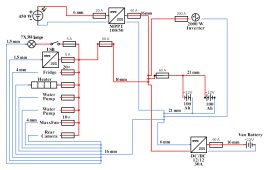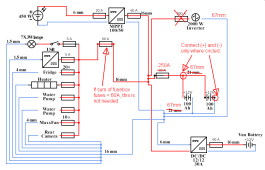josequesado
New Member
- Joined
- Nov 18, 2021
- Messages
- 25
So... Here I am once again. After some thinking and research finally ended up buying a Jinergy 450W half cell PERC panel (it's the biggest I could get that would fit and still leave a little room to pass on the side in the roof without stepping on it!).
Also I bought 2 100Ah Lithium batteries from Renogy as they were a good deal and I informed about costumer service in Spain and I didn't find as bad opinions as in the USA. Still, I hope I don't need them of course!
So, I'm now on the hunt for the rest of my system. I've contacted several electricians in the nearby but no one has the smallest idea apparently...
After all the considerations expressed here, I was thinking about:
- Victron SmartSolar MPPT 100/50
- Giandel 2000W 12V inverter (I was trying to get a Xandrex, but everything is out of stock...)
My question remains de DC-DC and the shunt.
As for the DC-DC: A Victron Orion TR Smart can give me 30A for 220€. A Renogy DC-DC can give me 40A for 145€. I've read that the victron might be better at not putting too much stress on my alternator. Does someone have knowledge as why to lose 10amps and spend 75€ more?
As for the Shunt:
- Renogy as a battery monitor (with shunt) for 57€. What would be the advantages of having the Victron Smartshunt over this one?
- Renogy also has a screen that connects directly to the BMS of their batteries for 45€.
I'm no expert as you can tell by my questions... Is there a good reason to spend those extra euros on a smartshunt? I want a durable system but I don't have infinite resources...
Thank you so much once again!
Also I bought 2 100Ah Lithium batteries from Renogy as they were a good deal and I informed about costumer service in Spain and I didn't find as bad opinions as in the USA. Still, I hope I don't need them of course!
So, I'm now on the hunt for the rest of my system. I've contacted several electricians in the nearby but no one has the smallest idea apparently...
After all the considerations expressed here, I was thinking about:
- Victron SmartSolar MPPT 100/50
- Giandel 2000W 12V inverter (I was trying to get a Xandrex, but everything is out of stock...)
My question remains de DC-DC and the shunt.
As for the DC-DC: A Victron Orion TR Smart can give me 30A for 220€. A Renogy DC-DC can give me 40A for 145€. I've read that the victron might be better at not putting too much stress on my alternator. Does someone have knowledge as why to lose 10amps and spend 75€ more?
As for the Shunt:
- Renogy as a battery monitor (with shunt) for 57€. What would be the advantages of having the Victron Smartshunt over this one?
- Renogy also has a screen that connects directly to the BMS of their batteries for 45€.
I'm no expert as you can tell by my questions... Is there a good reason to spend those extra euros on a smartshunt? I want a durable system but I don't have infinite resources...
Thank you so much once again!
Last edited:




